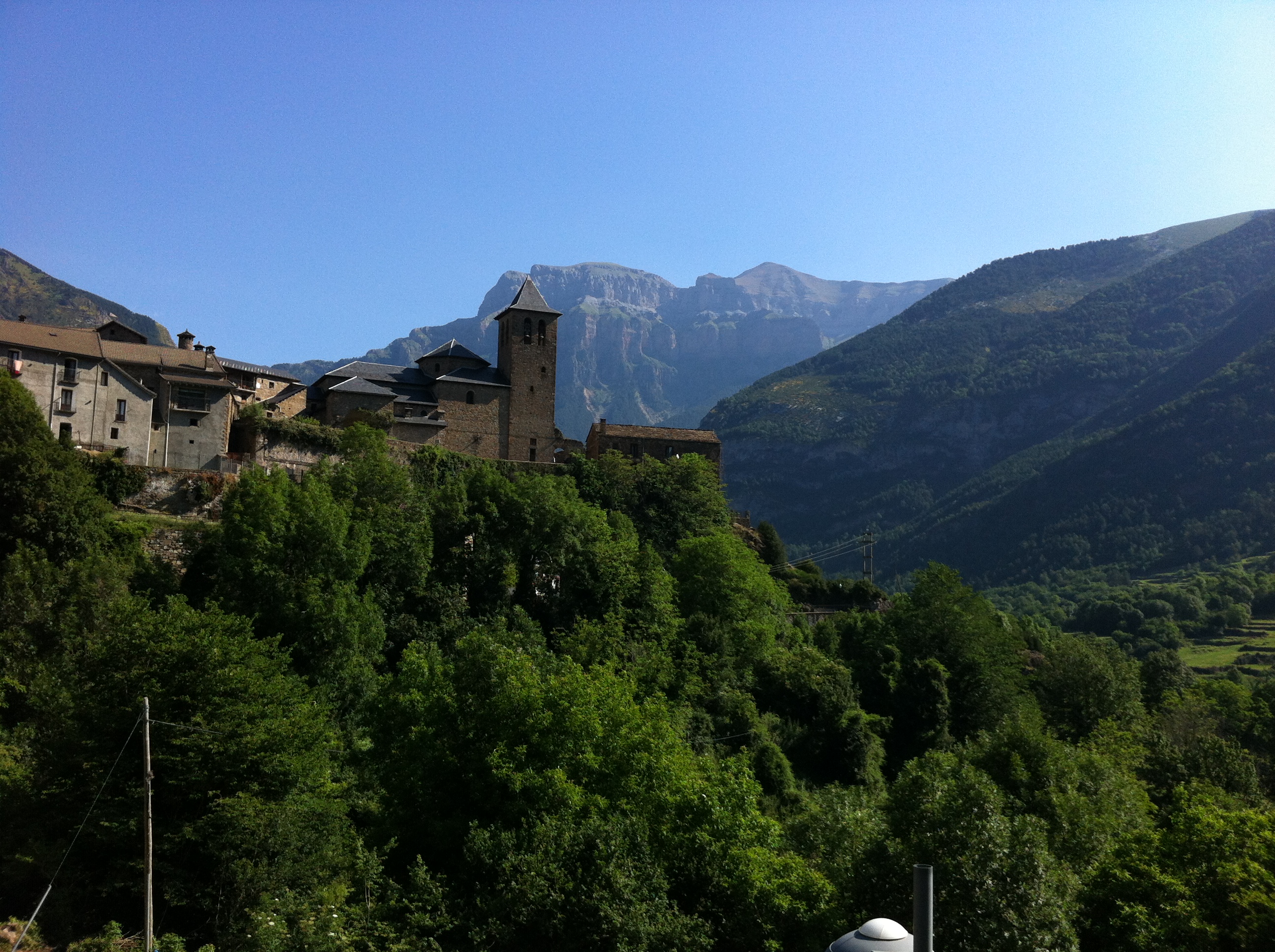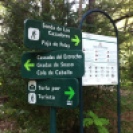June 28, 2017
For a blog post on walking

Established in 1918 the Parque Nacional de Ordesa y Monte Perdido was Spain’s first protected area and an undisputed highlight of the Pyrenees. Covering an area of 156 square kilometres the park contains the showcase valleys of Ordesa and Anisclo. In 1997 it was made a world heritage site by UNESCO and it is also part of the Ordesa-Viñamala UNESCO Biosphere reserve.
Ordesa is definitely a popular destination in the Spanish Pyrenees. We walked three valleys: Ordesa, Anisclo and Tena, and Ordesa was the busiest. To avoid the largest crowds in July and August, we visited Ordesa in the middle of June. During the months July, August and the first half of September, visitors are not allowed into the park by car. A bus service brings tourists in from Torla by bus. But in June you can freely enter with your own car. There is a visitors’ centre in Torla, with nice exhibitions about the fauna and flora of the area.
We chose the Silken Ordesa hotel in Torla-Ordesa. The hotel offers ample parking space to its guests. We booked half board, so we could use all our energy for walking during the day.
They serve a very decent breakfast, and a three course dinner. You can choose between five dishes for each course. The service is very friendly, the food very well prepared, the portions large enough. Drinks are cheaply priced.
The rooms are not very large, but spacious enough, the bathrooms modern. We slept very soundly in the comfortable beds. There is a TV set, a mini bar and free WIFI throughout the hotel.
The hotel boasts an outdoor swimming pool, that opens from June 15th onward. By the pool you have great views of the surrounding mountains. The hotel also has a spa area, for which you have to pay extra. We did not use it, so I cannot say if it is good or not. The hotel has a lift, which can be handy after a long day walking. And the hotel is just a 5 minute drive from the Ordesa National park headquarters and parking lot, Pradera de Ordesa .
You can make several walks inside the Ordesa Park. There is the popular valley walk, that brings you past the different waterfalls. It takes one hour to the first and second waterfalls: cascada Arripas, and Cascades La Cueva and El Estrecha, two hours to a series of small waterfalls: Gradas Soaso and three hours to the plain: Circo the Soaso and the third waterfall: Cola de Caballo (pony tail waterfall). From there you can can continue to Refugio de Goriz which is the base camp to climb mount Perdido; with 3355m the highest peak of the Spanish Pyrenees.
Because I did not feel too well on our first day, we decided to make a short walk from the parking area to the first waterfall, cascada Arripas, take in the views of the Cueva and Estrecha waterfalls, cross the river (Rio Arazes) and walk back to the start on the other bank of the river. This walk took about 2,5 hours in total and is very light. We took time to view the different waterfalls and took a long break to eat a small picnic while looking at the vultures that were circling over the Canyon. The weather was great, sunny with blue skies, and a light wind, so we really enjoyed our first encounter with Ordesa valley and were impressed with the immense peaks and cliffs around us. Nature is awesome, breath taking, immense, overwhelming, rough, with beautiful fauna and flora.
Enchanted with the area, we decided to see more of it the next day. We wanted to walk the whole valley, and because we wanted to try another route, decided to walk to the end of the valley by first taking the upper route: Faja de Pelay. Because the weather announced possible rain in the late afternoon we thought it wise to start with the difficult part: Faja de Pelay. That way we could walk back by the less strenuous route through the valley. The route through the valley partially runs through the forest, so we would be sheltered more in case it started to rain. We packed our raincoats.
I have to admit that we did not study the route very well beforehand, mainly because we knew that the walking routes in Ordesa valley are all clearly signposted. We were a bit taken back by though the difficulty of the Faja de Pelay route.
It starts with a long, two hour non stop climb, over a well marked path with lots of loose rocks. It is quite intense, especially because it was quite warm that day. But the reward when you reach the upper part of the route is really worth the effort. After the two hour climb you walk high up on the balcony in the upper cliffs for some 8 km from the head of the canyon to the incredible viewpoint (1900m) around two-thirds of the way. You have stunning views of the canyon before and under you, with views of the largest waterfall, Cascada de Cotatuero, on the other side.
The way down is more relaxing, and slowly takes you back down into the valley. The whole walk from start to the end of the valley near the Cola de Caballo waterfall took us five hours. The guide mentions four hours, but with the warm weather and some stops it easily lengthens to 5 hours!
There is a sign at the other end of the Faja de Pelay route in the valley, that advises people not the start this route back after 3 PM. (do heed this advice!) When we arrived in the valley at Circo the Soaso, the weather turned almost instantly for the worst.
A thunderstorm broke loose, and we sheltered a bit under a large rock to put on our raincoats. We continued when there was a small lull in the rain, but just a few minutes later all hell broke loose with hail coming down. I had never experienced such a heavy thunderstorm before, and not before long, we were completely soaked, up until our underwear. We crossed the river on the plain as fast as we could and aimed for a small hut I had spotted from the road above. We reached it but were already completely wet by then. We entered and the place was already quite full with about 20 people taking shelter. For 45 minutes we waited for the hail to stop from coming down. Many people who came after us could not enter any more because the hut was already crowded, so they had to continue in the heavy weather. Some people came in dressed in no more than a light shirt and shorts, no rain clothes and already suffering from light hypothermia. After 45 minutes we were also starting to get cold, and together with two other women decided to go for it, and left the hut.
It started to hail again, but we continued anyway. In no time our sturdy walking boots were soaked and rivers started to form inside our shoes. The river itself had swollen, doubling in size and coming down with force. Multiple waterfalls were coming down from all sides of the cliffs inundating the road in many places. Walking kept us warm so we continued while longing for a long hot shower! The hail had formed a white carpet on the ground, it looked like it has just snowed. After 2,5 hours we made it back to our car safely. I regretted that I hadn’t taken a fleece sweater and our ponchos with us. One of our camera lenses suffered water infiltration. And although we had prepared well enough: checked the weather forecast and planned our route accordingly, packed rain clothing, a first aid kit, water, food and maps and wore long pants and hats, …, I decided I could do better because the force of the storm had taken me by surprise. You have to experience the force of nature to really understand the dangers of walking in the mountains. But most of all I was shocked by how little prepared other visitors had come to the start of their walk here! Although it was only June, we had July weather. Very warm during the day, between 26 and 30° Celcius, and because of the heat, the predicted thunderstorm formed at the end of the day, around 3 PM.
It took 48 hours for our walking boots to completely dry out. Luckily we had some lighter spare walking shoes with us to use the next day.
The walks in Ordesa valley are really beautiful, they are well signposted, there are walks of different difficulty levels and duration. I advice to choose the valley walk if you are not sure of your own condition. The Faja de Pelay is definitely a very very beautiful walk, but you need to have some basic condition, because the whole walk (the way there and the way back) can take at least 7 hours and includes a long and steep ascent or descent. The Ordesa area is very popular and tends to get very busy in July and August and during the weekends. We noticed many visitors started walking up to the Refugio’s on Friday evenings.
So, do not underestimate mountain weather, and the sudden change the weather can take. Be prepared for hot, cold and rainy weather. Take enough water and food with you. Study your walking route and the weather forecast before setting out. As the Torla visitor centre states correctly, ‘we do everything for your safety but it stays your responsibility’.
Packing list for day walks:
To wear: zipp off walking trousers, t-shirt, hat, sunglasses and waterproof mountain walking shoes. To pack: rucksack with a fleece, raincoat, raincover or poncho, scarf and gloves, waterproof trousers, sunscreen, first aid kit, map, your passport and insurance card, your mobile phone, camera, 1 to 2 l water (you can refill at mountain streams, but not if there are cows or sheep grazing nearby), snacks like cookies, muesli bars, dried sausage, dried fruit and nuts, fresh fruit.
Nothing I mention in this list is unnecessary. You will not always need everything, but if you get stuck into a storm like we did, you will feel so grateful you packed all of it!
In the local supermarkets or tourist shops you can easily find the Mapa excursionista on a scale of 1:25.000.
For a blog post on walking Anisclo canyon:
Anisclo valley in Ordesa






















































Pingback: Anisclo valley in Ordesa | chefmaison
Pingback: Two walks in Valle de Tena | chefmaison